Playroom ideas – 25 fun yet stylish designs that kids of all ages will love
With these fun and functional playroom ideas for storage, furniture and more, you can convert your home into the ultimate playground for kids
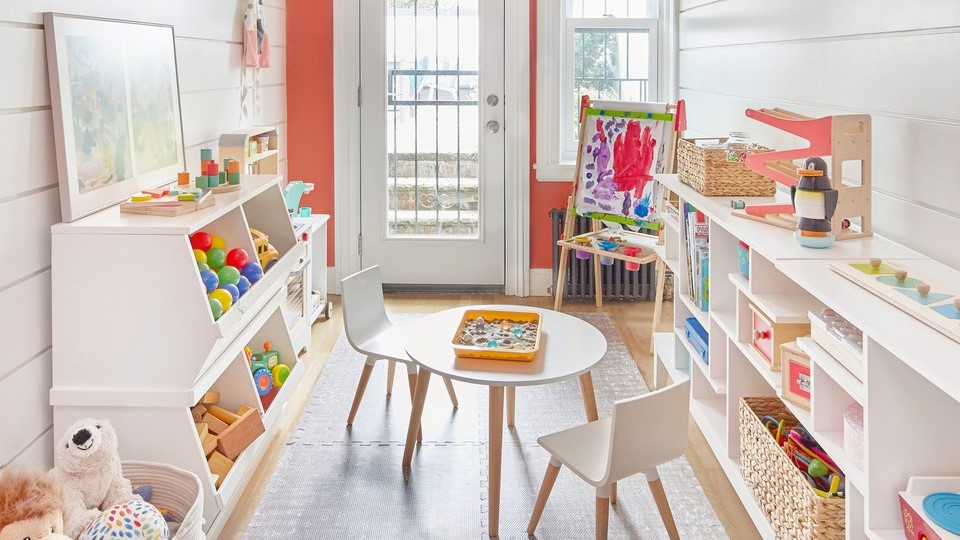

Lotte Brouwer
Parents are always looking for playroom ideas that maximize fun but minimize chaos. From at-home climbing walls, and arts and crafts stations, to cute teepees taking over the space and useful storage solutions, this room can truly become an indoor playground that keeps the kids entertained when you need it.
There are several ways to make sure that a playroom is as imaginative and creative a space as the kids' rooms, with all the storage you need to keep it tidy.
'Kid spaces can be so magical because you can bring in some whimsy and bold moves without too much stress,' says Jennifer Morris, interior designer and founder of JMorris Design. 'This is a great place to experiment with bright colors and smart storage ideas.'
We've rounded up some of the most useful ideas for playrooms where art, music, and toys are always at the ready with expert advice from leading interior designers.
Playroom ideas for all ages, from young kids to teenagers
1. Turn stereotypes on their head
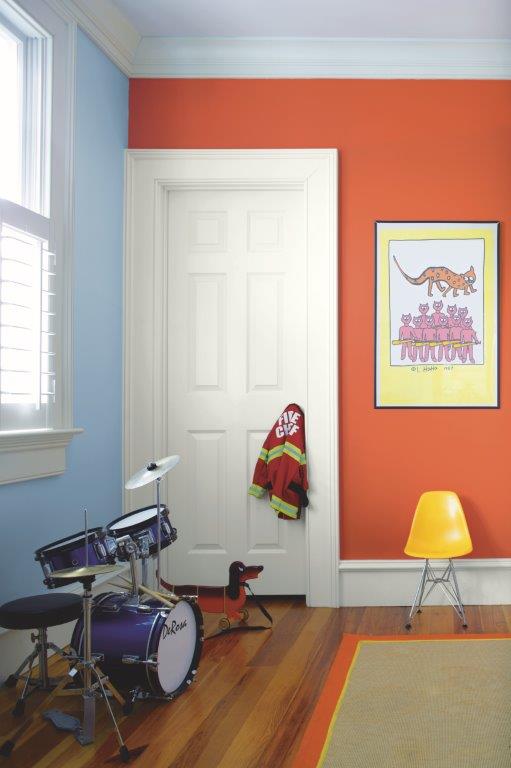
The pink-for-a-girl, blue-for-a-boy rule of thumb has been thankfully relegated to the décor doldrums in recent years in favour of less polarizing hues. 'People are moving away from the very traditional stereotypical gender-based colors for kids rooms,' says Helen Shaw, Director of Marketing at Benjamin Moore. 'In general, green paints have become very popular to use, but it's more like a khaki green. And then instead of pink we're looking at coral and terracotta – something that is a little bit more liveable than a Barbie pink,' she adds.
Other designers are taking their cues from nature itself. 'We love vibrant greens, sky blues and fresh yellows for a playroom,' says Russell Whitehead of 2LG Studio. All these shades evoke a sense of excitement, without being so peppy or zingy that they're the equivalent of a sugar rush.
Of course, better still, involve your child in the process by allowing them to pick a color as part of the scheme.
2. Link the playroom to the rest of the home
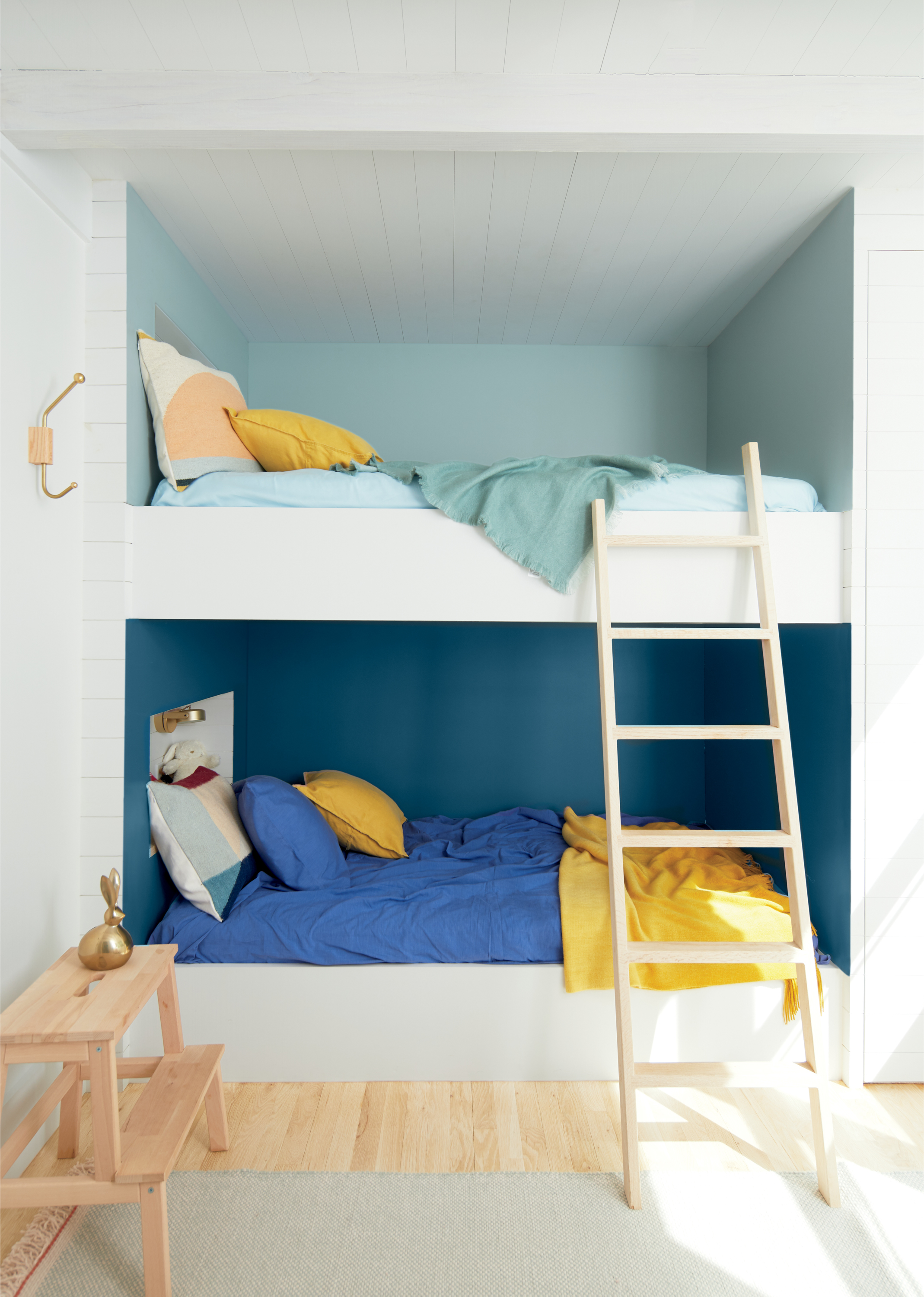
Is this space to be an extension of the rest of your house or an unashamed child-centric zone? Perhaps your nursery is a bit of a thoroughfare and will need to chime harmoniously with other rooms flanking it?
Helen Shaw recommends studying the color wheel to guarantee a palette that doesn't jar with your home. 'When you've got open plan spaces adjacent to each other, or even areas that flow from one to the other, the trick is to try and have colors that are from the same color family or an adjacent color family,' she says. 'If you keep within the adjacent families, then you know you're not going to have a scheme that clashes. As soon as you go into the opposite sides of the color wheel, you've got something that's a little bit more energising in terms of a color scheme,' she says.
For opposing colors to work, it's important to make sure they are balanced in terms of their vibrancy and also their value – which means how grey they are. 'For example, if you put a bright clean red like a pillar box red with a muted green, it doesn't go as well as if you combine a muted red and a muted green,' she explains.
3. Include accent furniture
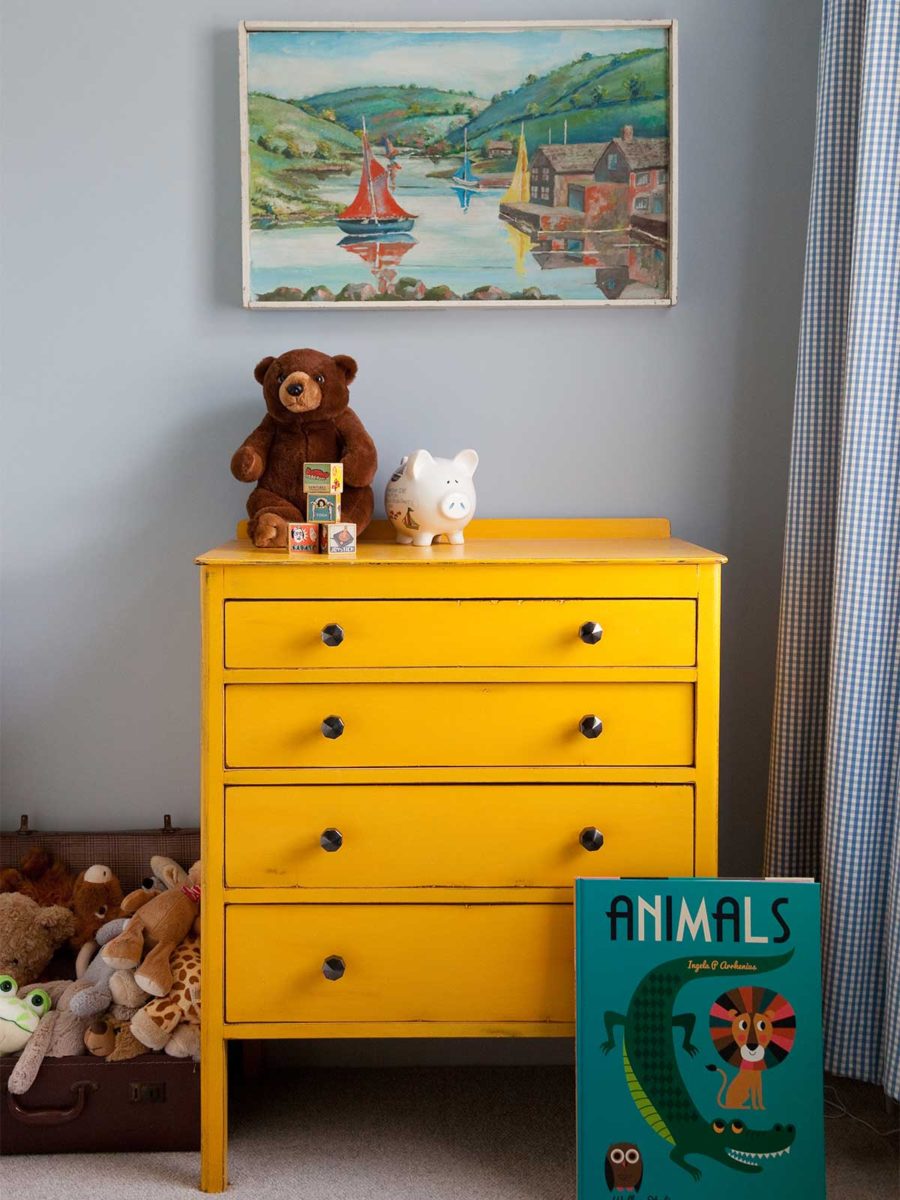
While accent walls have made a comeback, Accents are a really easy, time-and-wallet friendly (and fun!) way to incorporate splashes of color into a playroom scheme.
Helen Shaw of Benjamin Moore recommends using paint as a backdrop for pieces of furniture in the room, or around fixtures such as a chalkboard or desk area.
'If you've got a desk in a corner, you can just do a zone around that desk with a little burst of color. Or some sort of a geometric shape that creates that zoned area, framing either a piece of furniture or something on the wall. It doesn't feel massively dominant because it's behind furniture or behind a picture, but it does give you some injection of color,' she says.
Russell Whitehead of 2LG Studio goes one step further and suggests using colour to accent the furniture itself: 'Allowing space for a hidden den (no matter how small) is a winner – we love to personalise these dens with color,' he says.
4. Future-proof the decor
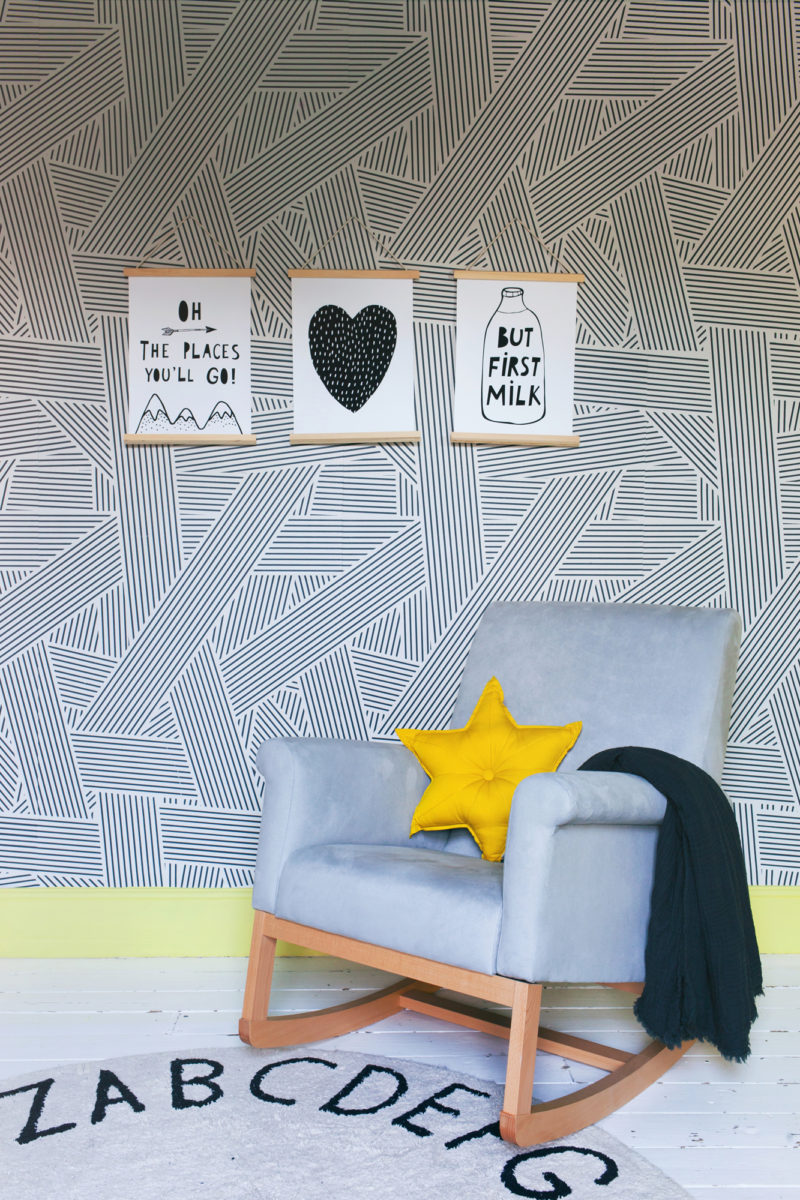
Playrooms are a space that will need to flex with a child as it grows. Yes, it won't be as long as you think before your pondering the decor of a teenager's bedroom. But until then, consider how the purpose of the room might change over the coming years to avoid having to redo frequently.
Graphic shapes are timeless says Russell Whitehead of 2LG Studio. 'Geometrical or organic motifs for murals or wallpapers are a great option as they have longevity and still feel relevant long after toys have been grown out of,' he says.
'Don’t be misled to believe that certain colors are childish and others more grown up. That is individual and down to how they are used, so allow a playfulness in the color choices without fear of being too young. We can all be young at heart,' he adds.
5. Work in recycled materials where possible

Playroom ideas need to remember that this is a space that your child will spend a large portion of time in. So be sure to strike the right chord with non-toxic eco paints and eco-friendly materials.
Helen Shaw, Benjamin Moore says, 'There's so much greenwashing in our industry, but I think in general, most water-based paint for walls now has a VOC rating of low to minimal. There's a new band now called Trace, which means that the amount of fumes that are coming off of the paint are going to be almost nothing – you're not going to be disturbed by the smell of the paint in your home and it's going to be safe for your children as they won't be breathing in anything toxic.' Russell Whitehead recommends amplifying color with natural, tactile materials to stimulate the senses and encourage curiosity.'
Natural and sustainable materials are a great choice in a playroom. Cork flooring, recycled plastic, sustainably sourced wood and marmoleum or lino are our go to materials,' he says.
6. Make a playroom multifunctional
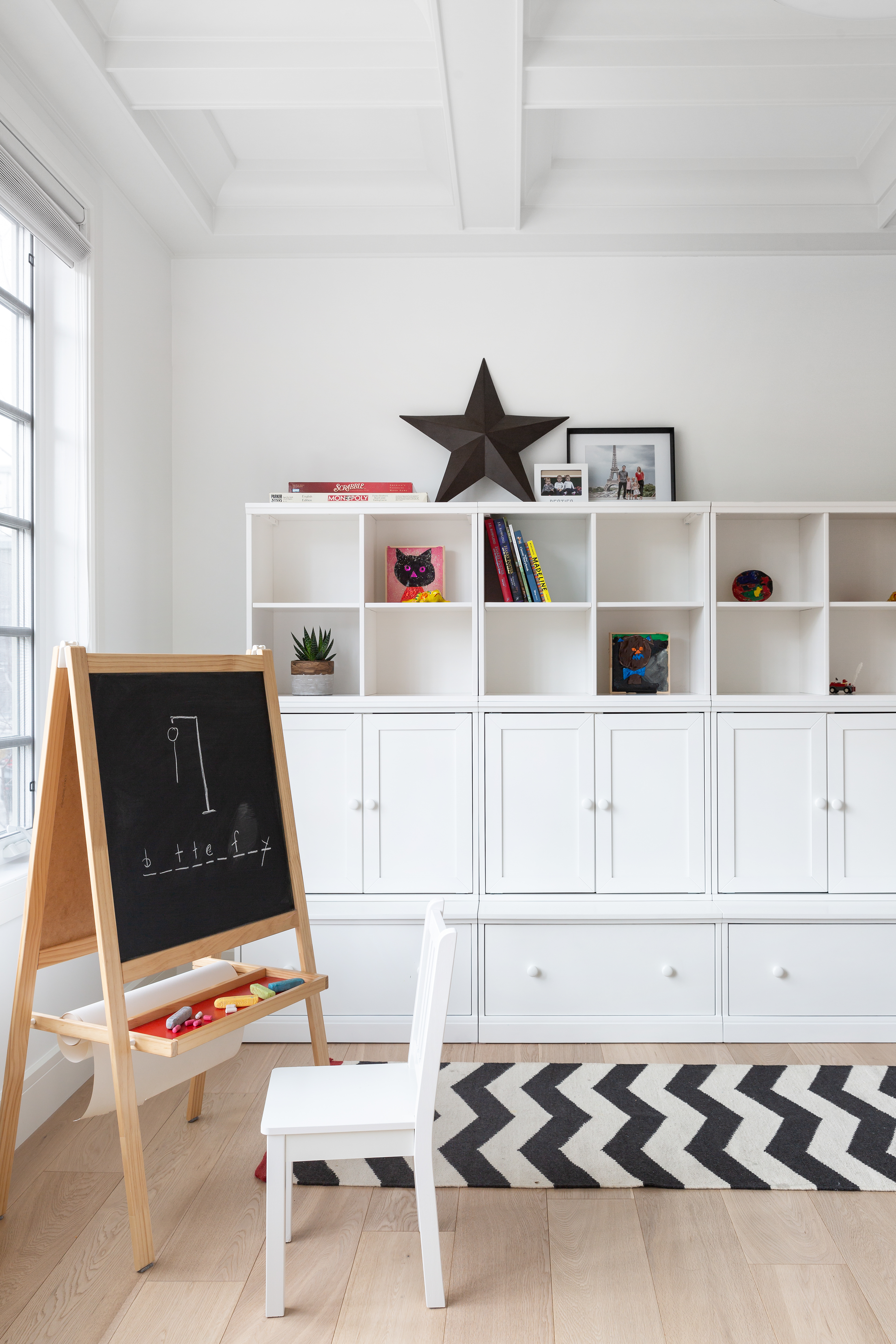
When decorating an apartment or a smaller home, it may not always be possible to dedicate an entire room to play. In that case, you could consider making a room multifunctional to add a playspace there.
'This playroom is located in what would normally be the formal dining room of the home,' says Alanna Dunn, interior designer, Reena Sotrupa. 'Given that our clients were more casual entertainers and that their children were so young, they opted to use this space as a playroom until the children grew a bit older. This is the reason the space has such a beautiful coffered ceiling. In a few years, the time will come to convert it into a dining room again.'
'To design it, we used an oversized pinboard to neatly collect the kid's art in one location. Knowing that kids' toys are inherently colorful we chose to keep the foundational elements of the room completely white,' says Alanna.
7. Opt for easy-to-reach playroom storage
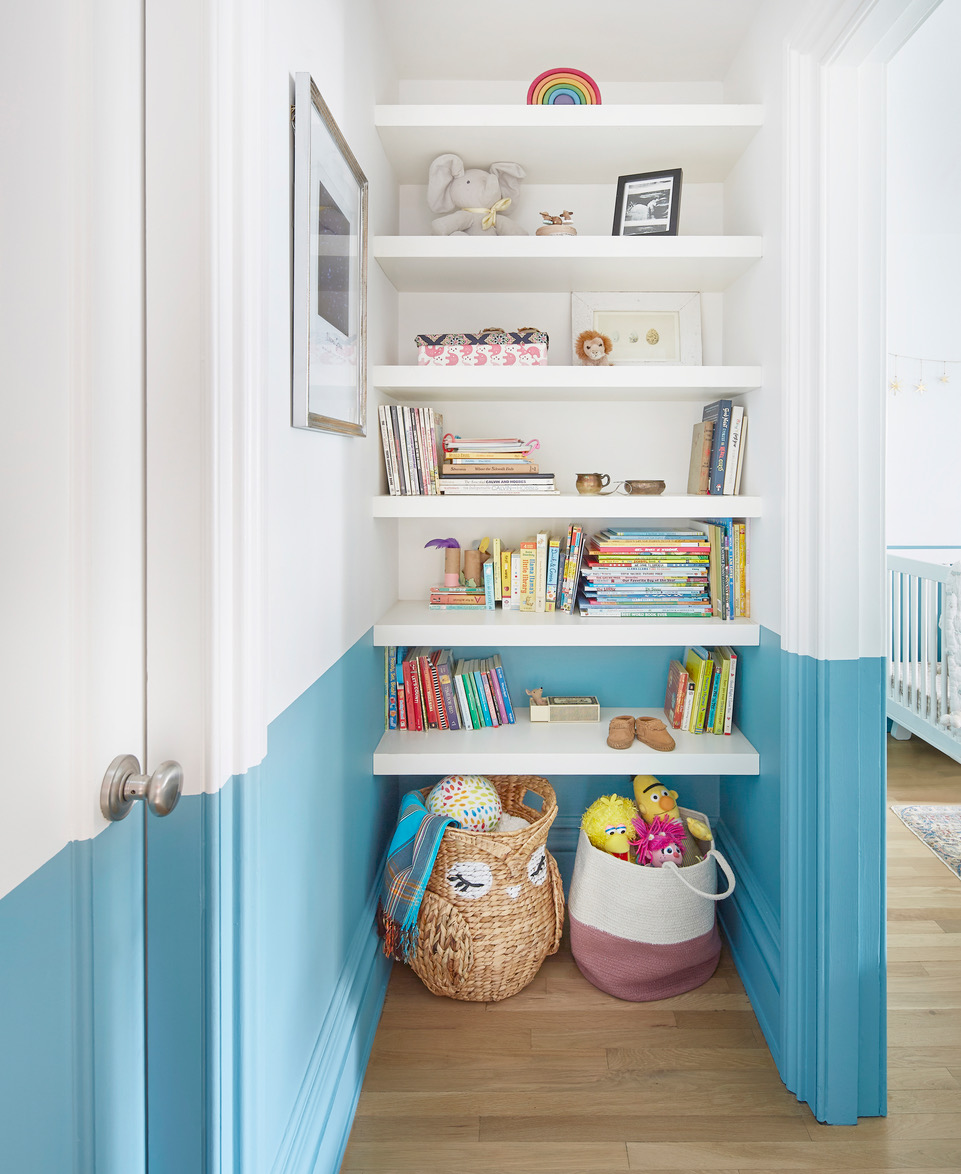
'When it comes to designing this space, I caution about hiding the stuff away,' says interior designer Jennifer Morris. 'In my personal experience, anything behind a door will collect dust and be forgotten. So I lean toward open shelves with bins that are easy for everyone to pull out. I am big on reading so I love adding a library to any place.'
Open shelves are great playroom storage ideas to display some of the best things your child owns. If he/she has a lovely collection of action figures, has created beautiful objects with LEGO, or has a big collection of books, these can double as decorative elements and will look great on open shelves. They'll add color to a white wall and enliven the mood of the space.'
8. Design the play space as a boat house
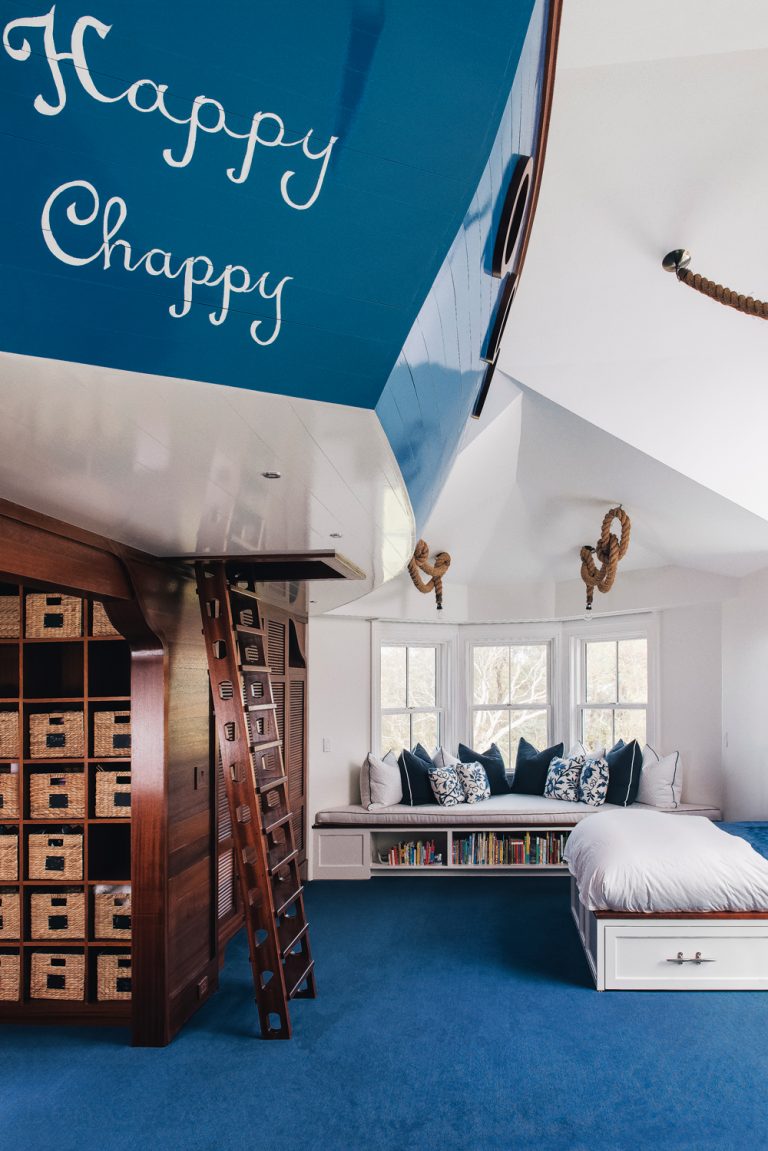
An important point to acknowledge is that children are active and want to climb. So whether it is steps, a ladder, or a rope hanging from the ceiling, a kids' room should be filled in ways that spark the child's curiosity to explore.
This indoor treehouse is in the shape of a boat, complete with a wooden ladder, portholes for peeking out of, and decorative rope lighting (sourced from Etsy), hanging from the ceiling. There’s also a stash of books neatly displayed in the window seat, to encourage reading.
This idea can work perfectly well in a small boy's bedroom too, where a sense of adventure is always lurking above. The open shelves with baskets help keep everything organized and, the blue and white color palette conjures a peaceful oasis.
9. Induce whimsy with a swing
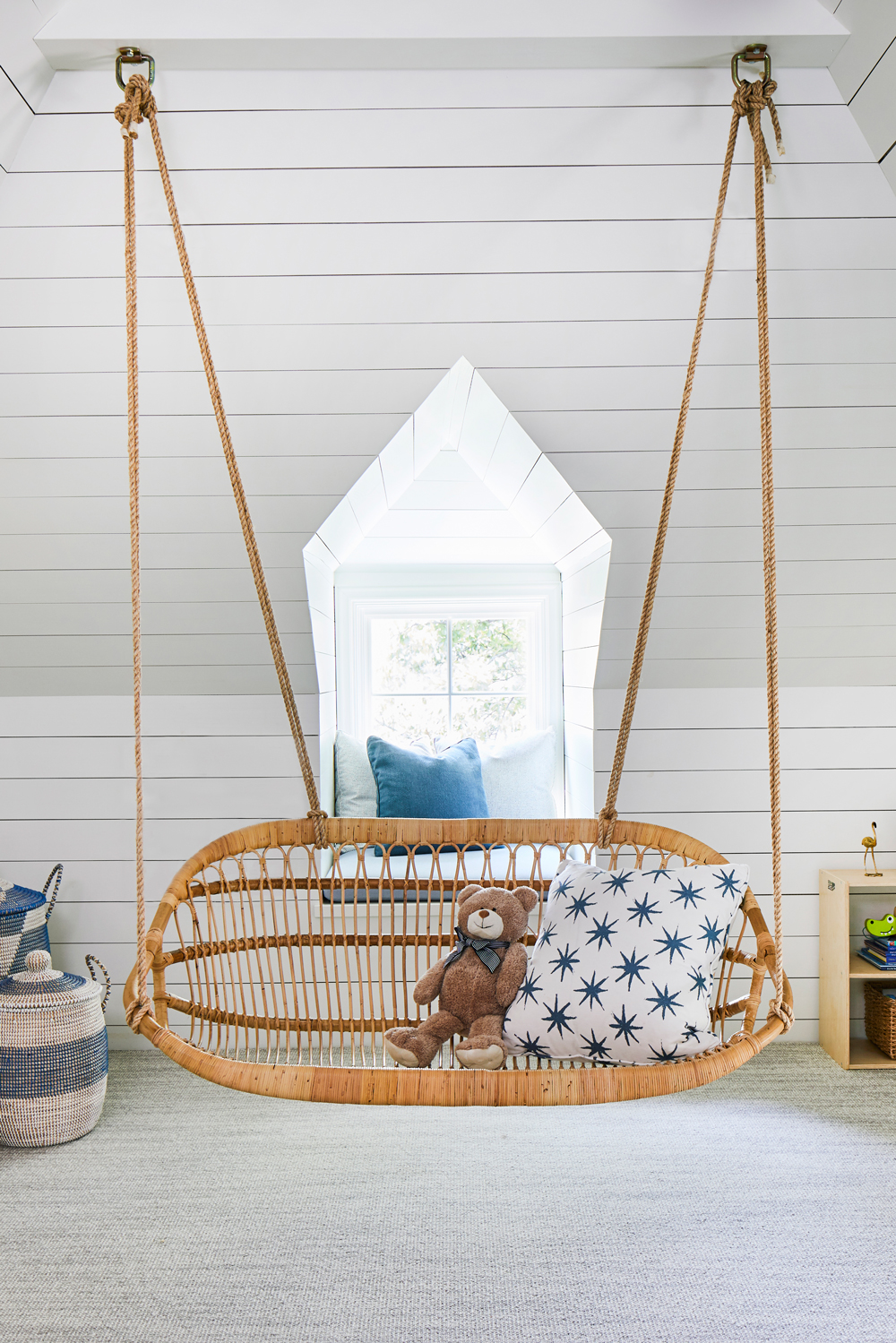
Why have a boring chair when you can have a swing seat? Ideal for reading and relaxing, these make a lovely addition to a playroom, especially smaller ones as it frees up floor space and light can flow around more easily. A swing works great as a nursery idea as well, where you could sit and rock the child while putting him to sleep.
Gloss white walls bounce light around, making this attic playroom feel clean, bright, and inviting. The swing seat makes this room a favorite spot to hang out and play.
10. Experiment with an indoor slide
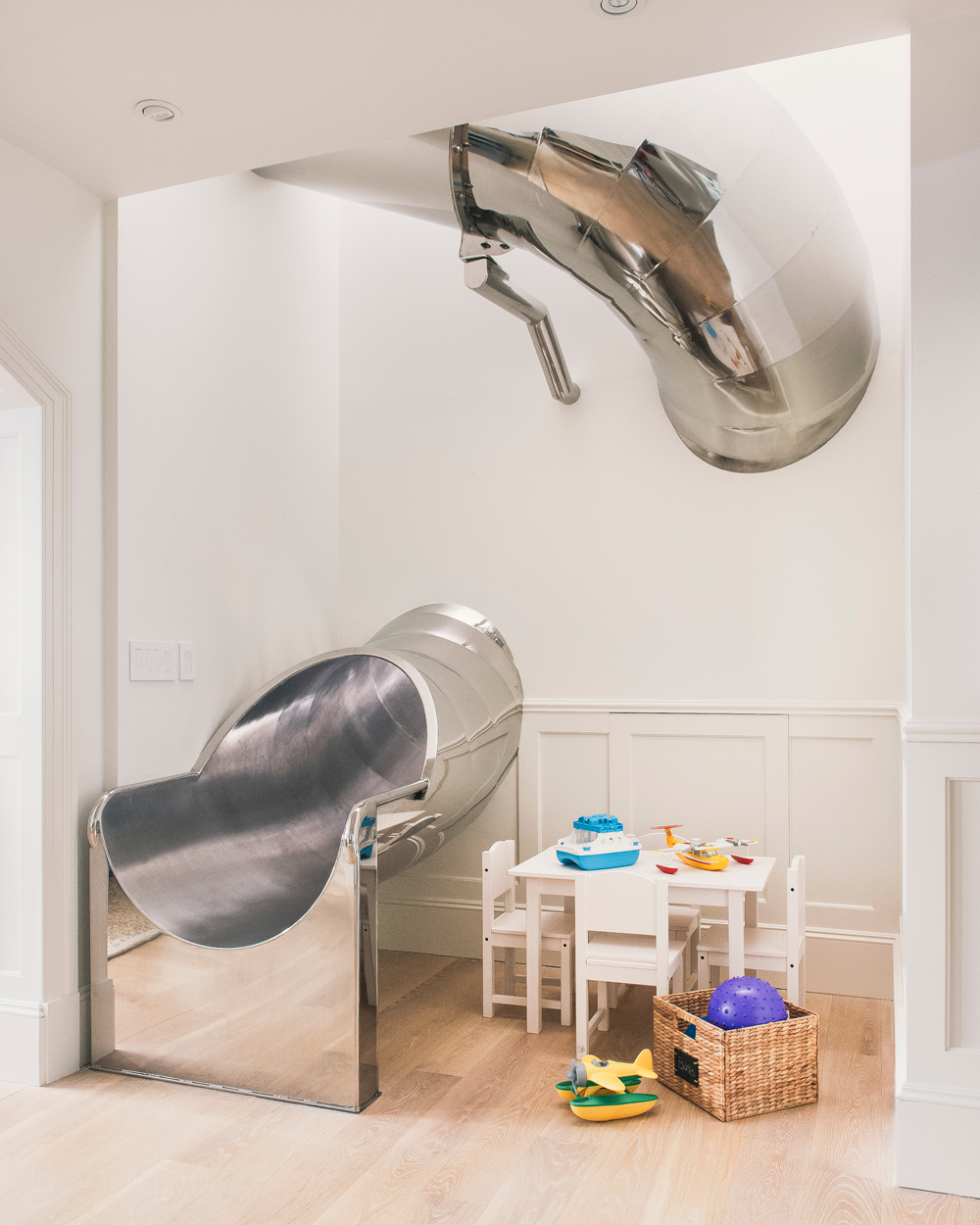
Surely it's every kid's dream to have a slide in their playroom. Of course, it's an investment but if you've got the budget and know it's going to be well used then go for it. In this playful home in Martha's Vineyard, the metal chute starts upstairs and twists down the house to a downstairs playroom; it’s safe for kids and big enough for young-at-heart parents.
11. Plan the acoustics in the playroom
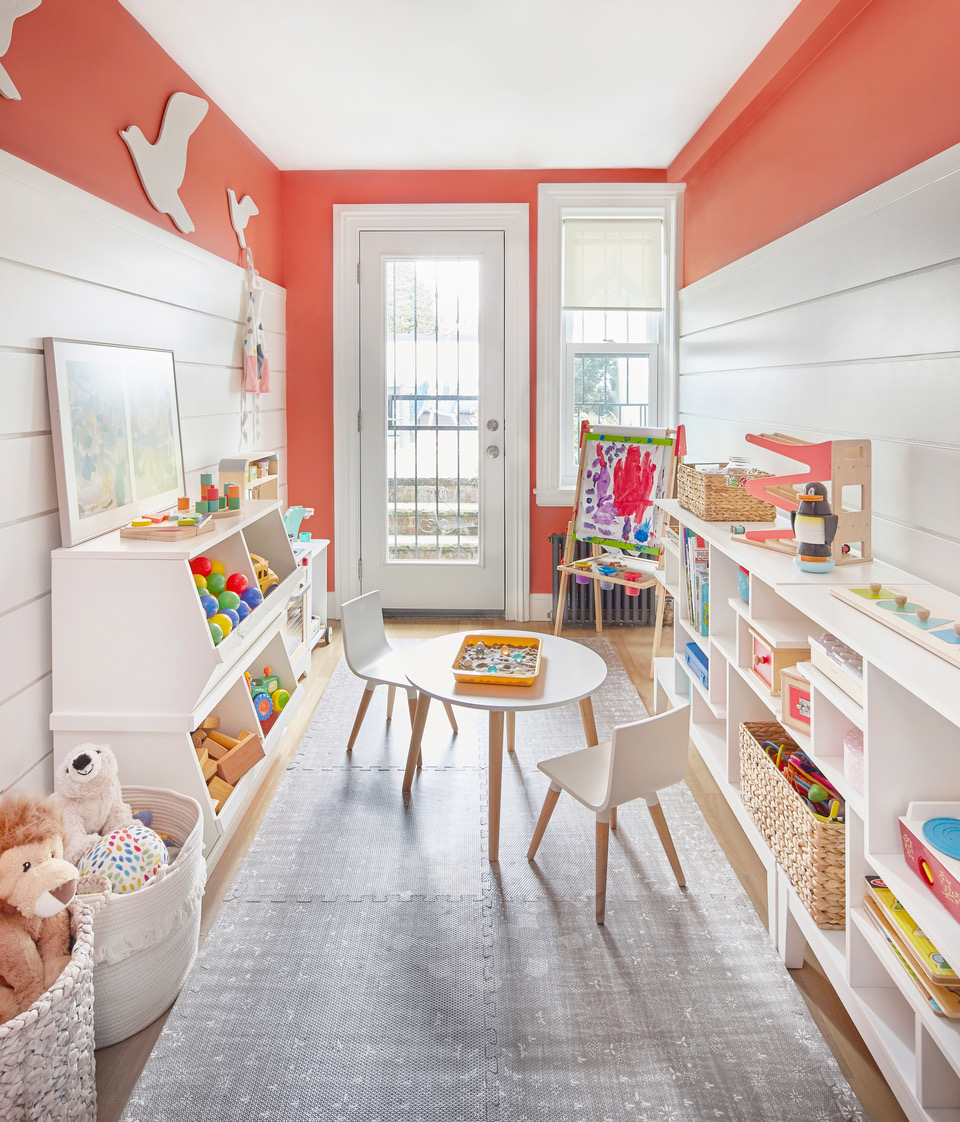
If you have two kids or more, or if their friends visit often, the playroom can quickly become a space full of commotion and noise. If you work from home, this can become a big issue. Consider sound-proofing the room or choosing clever acoustic features that muffle the noise, so you can live peacefully and fun doesn't have to leave playtime.
'Soft flooring for busy, clumsy bodies is always a good move and it helps with acoustics,' says Jennifer. 'I often add acoustical features like felt birds, fabrics and even zone the room with wallpaper. This playroom has acoustically-rated wallpaper on the ceiling to help muffle commotion and fun.'
12. Get creative with the walls
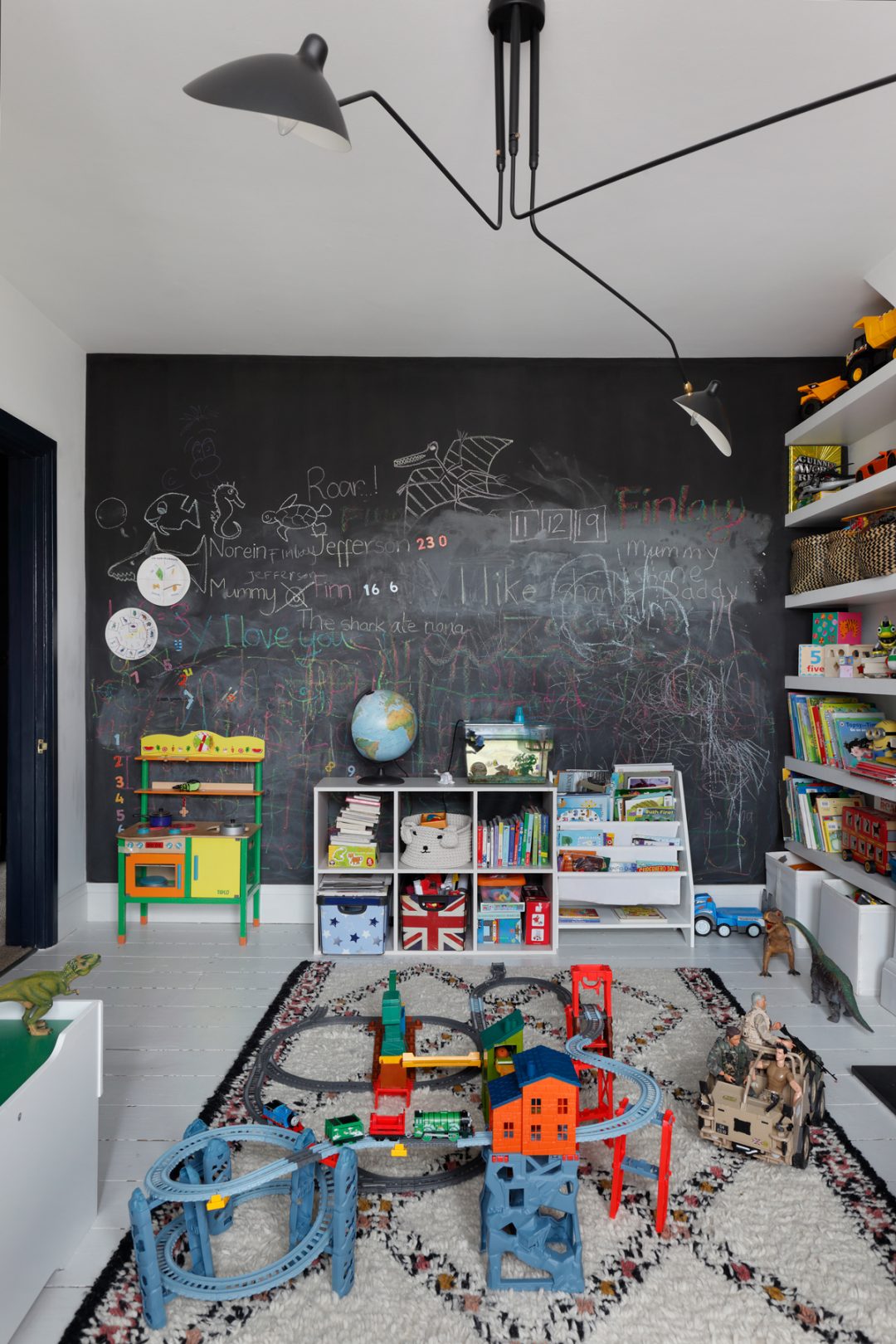
Forget off-the-peg posters – instead, give your kids creative freedom and allow them to use their artwork to decorate their space. After all, there is nothing cuter than a lovingly homemade potato print or stick person drawing.
A chalkboard has perennial play appeal, so take it one step further by painting a whole wall with blackboard paint. Ask them to get creative and wild – maybe even draw their very own wall mural idea. And, because it can be constantly changed, the art and the at-home gallery can stay dynamic.
13. Create space for homework in the playroom
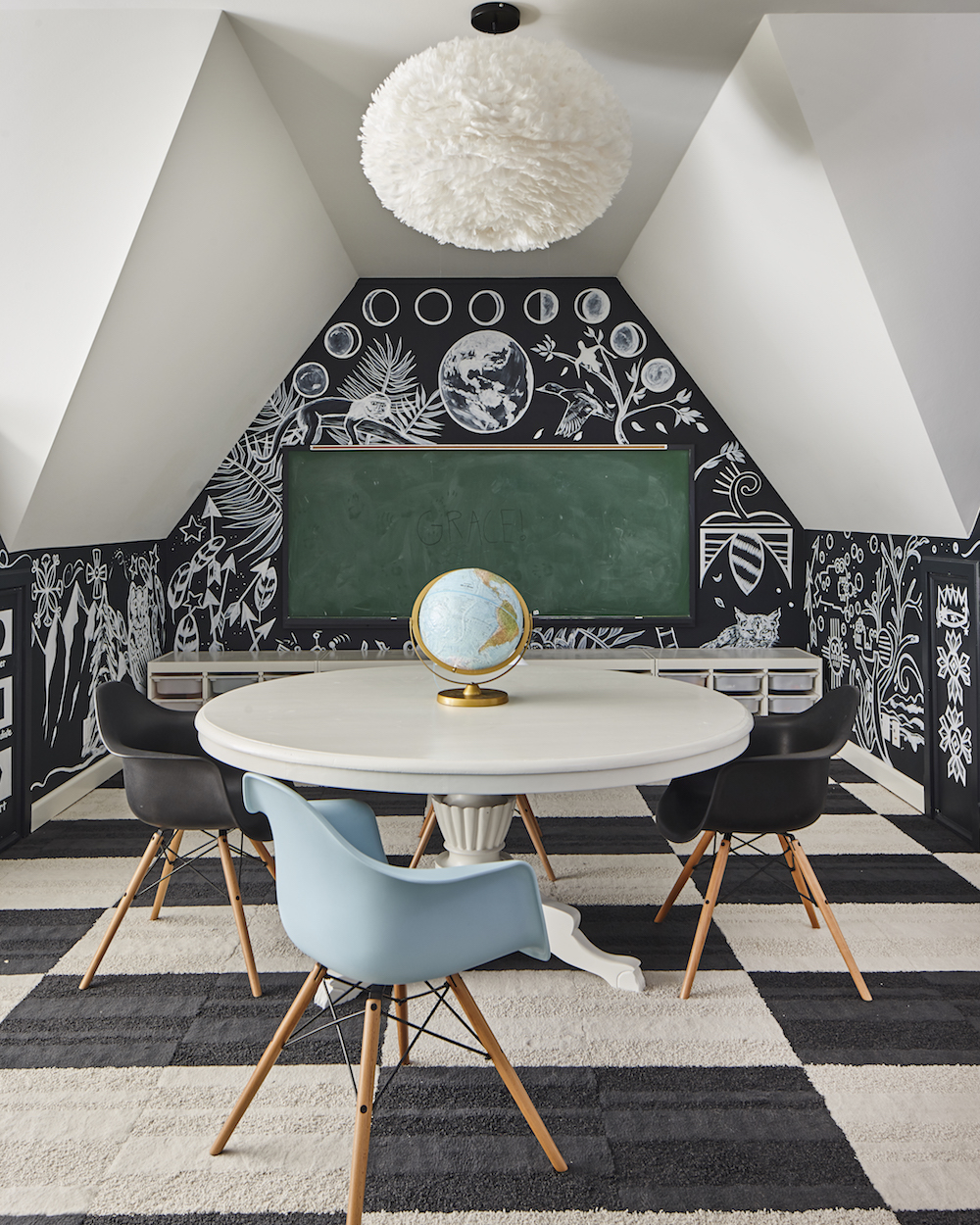
Most kids love to play school. So lean into that and double up a playroom as a classroom, complete with a chalkboard and a kids' desk. Make it feel more creative by also turning the walls into a chalkboard and working together to draw educational patterns all over.
This kind of setup is also perfect for when they do start school and use this area as a study space.
14. Convert a bedroom into a double-duty space
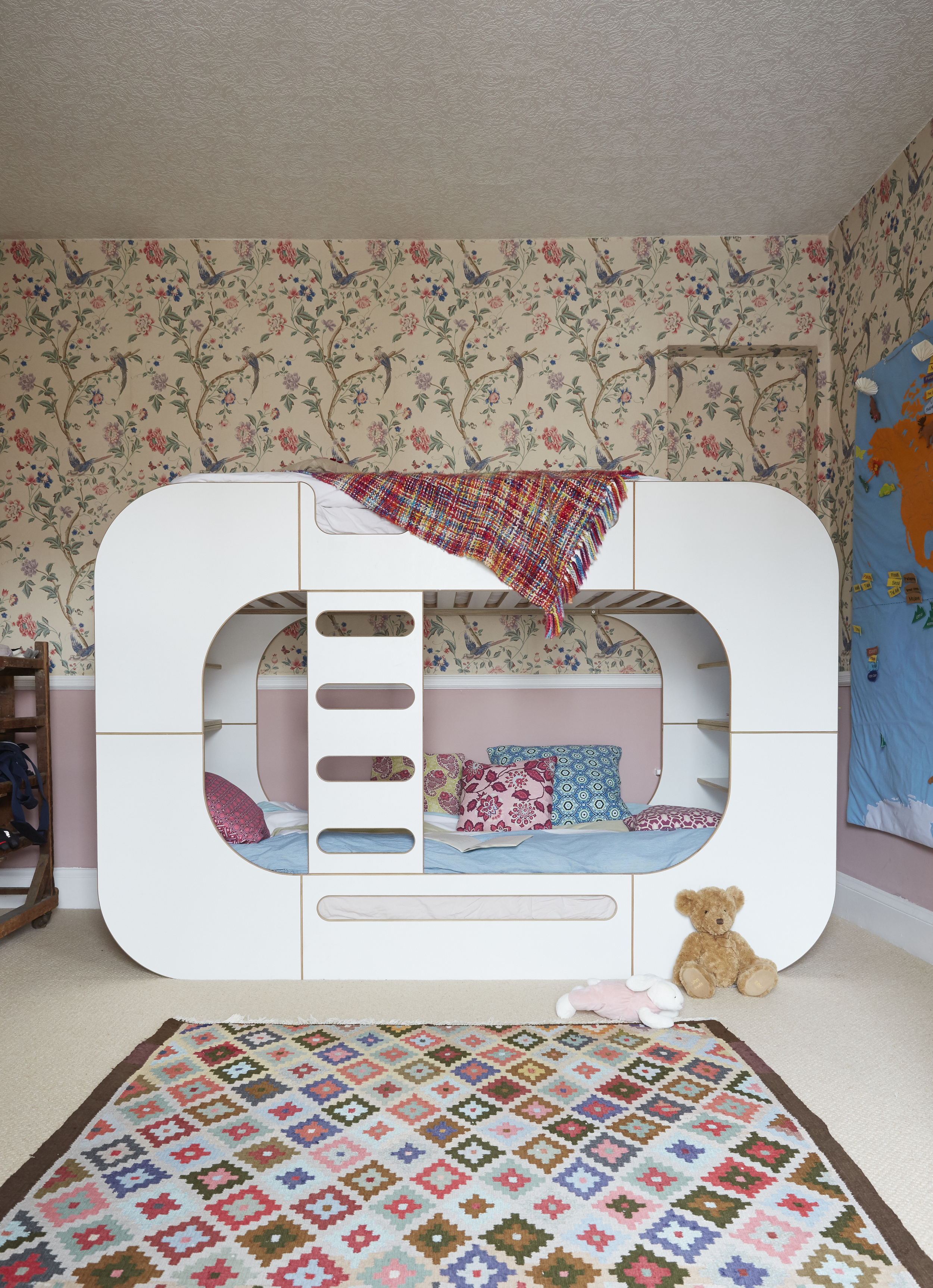
Let's be honest – kids prefer playing on the floor. If your kid's bedroom has enough floor space, use it to convert it into a playroom. With storage units, baskets, and open shelves, this space can be made into a playroom central. Create different zones with colors and shapes, so they know where to play, where to store things, and where to study.
A nice trick for bedrooms is converting play items into storage: objects that can be moved about and rearranged to create different places and backdrops to frame activities. This could encourage your child to become an architect or builder after having lived in a room that she can manipulate.
If you want to encourage your child's creativity, call a carpenter to make a few special pieces that are designed the way your kid wants.
If you're looking for sharing kids' room ideas, bring in a fun design for a bunk bed. Notice in this image, that the bunk bed looks like a fun, snug cocoon. The ladder adds whimsy and the lower bed has plenty of open shelves as storage.
15. Use an awkward alcove as a secret den
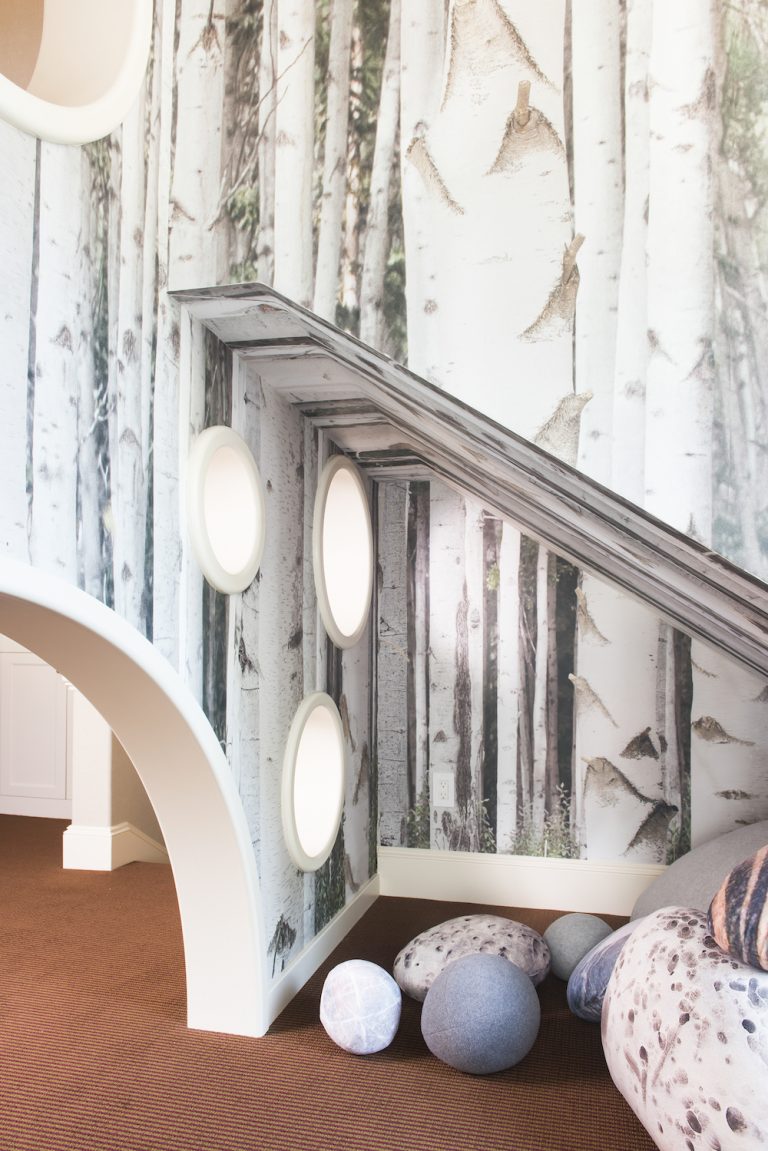
Maybe you aren’t blessed with a bonus room to dedicate to toys and crafts. But don't worry, even an awkwardly shaped alcove can come to the rescue for creating a secret play area. Get inspired by this picture and turn it into a den or an alcove storage space for toys.
This one was a bespoke creation, but you could recreate it by wallpapering the alcove in a similar forest print and just hanging some drapes to give it a cozy, den-like feel.
If you don't have an alcove or a corner but love the idea of adding mystery to the playroom, opt for built-ins that can hide a ladder that leads to a fortress tower or a balcony, where the kid can climb to fight dragons. The perfect stage set to grow up in.
16. Think of creative bed designs
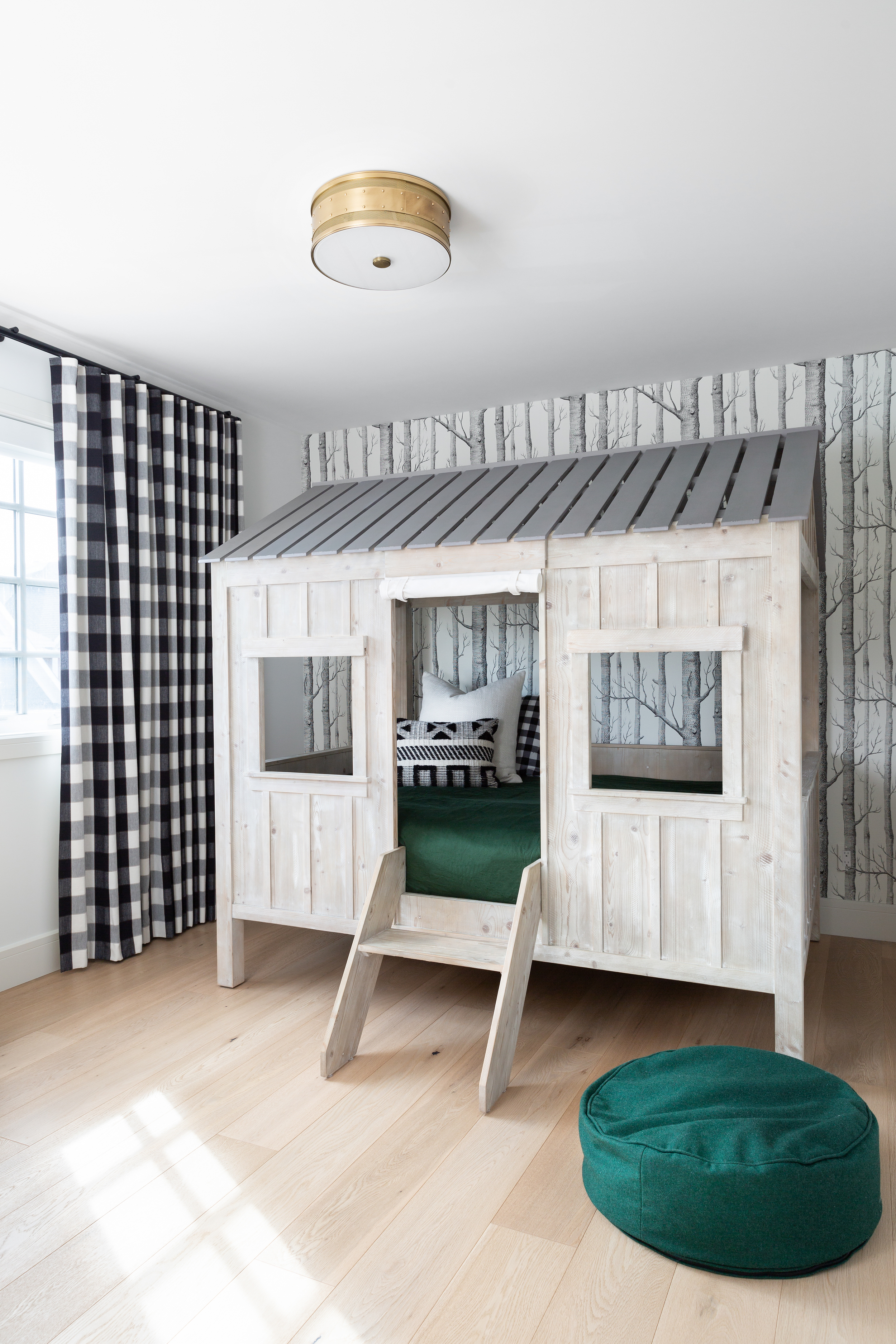
Let your child’s imagination run with dreamy beds. For instance, a small car bed is a great transitional one between a crib and a bed in a boy's bedroom. A wrestling ring bed is ideal for little WWE fans. If your child loves the yacht life, then a boat-shaped bed may be more to his or her liking.
These work perfectly well in playrooms too. Like in this image, the treehouse bed works well for all uses – play and sleep. While kids need a ladder to scale their way up to raised beds, consider adding a slide as well, for fun while coming down.
17. Make use of a mezzanine to add a playroom
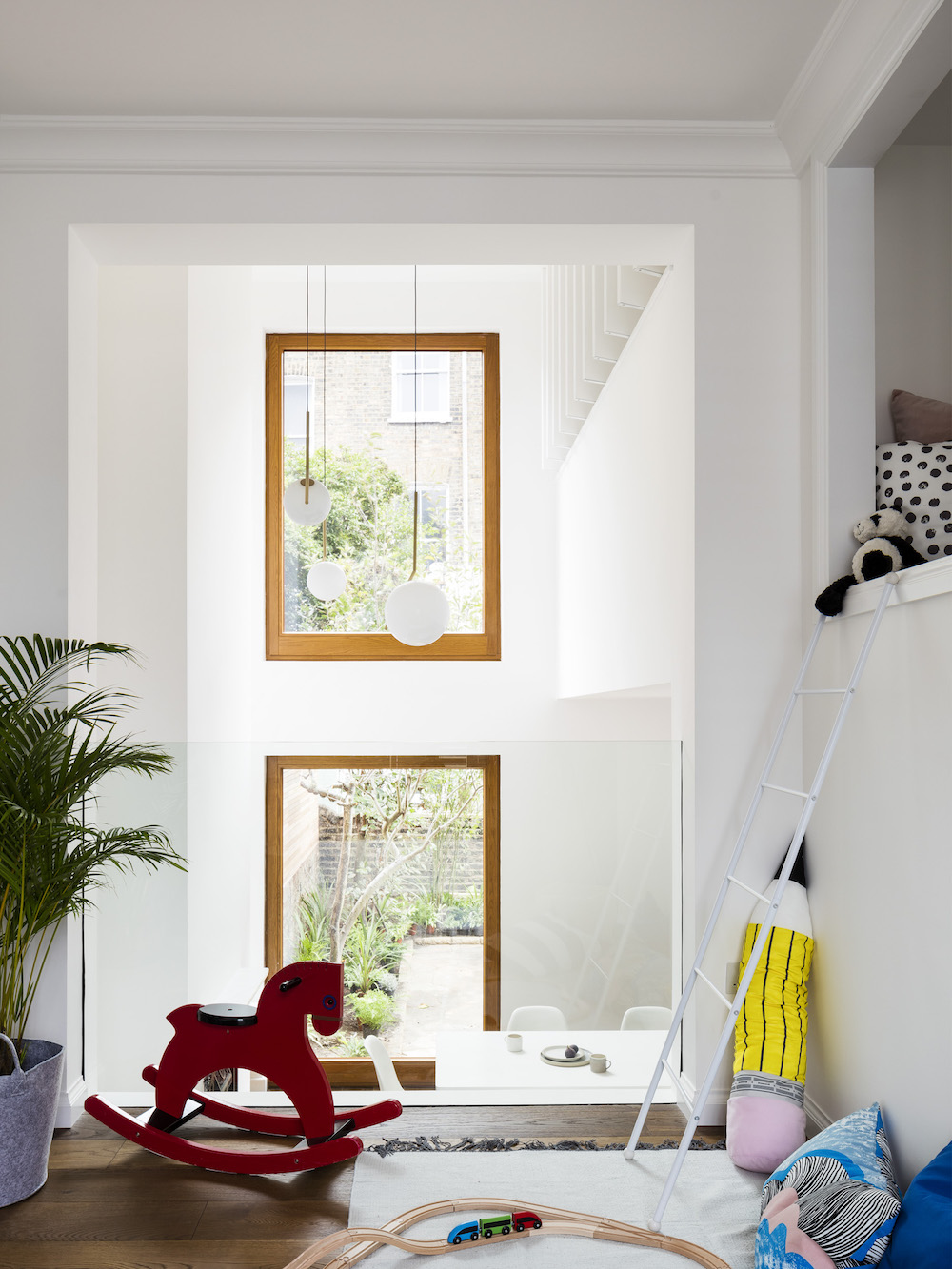
You don't need a huge amount of ceiling height to create a mini mezzanine in a loft apartment that can be used as either a sleeping area or play space. It even doubles your floor space.
This tiny playroom sits above the living room, on a mezzanine level that overlooks the dining space below through a glass wall. A raised mezzanine area with a built-in bed plays on the multi-level theme.
18. Install crates on walls for better playroom organization
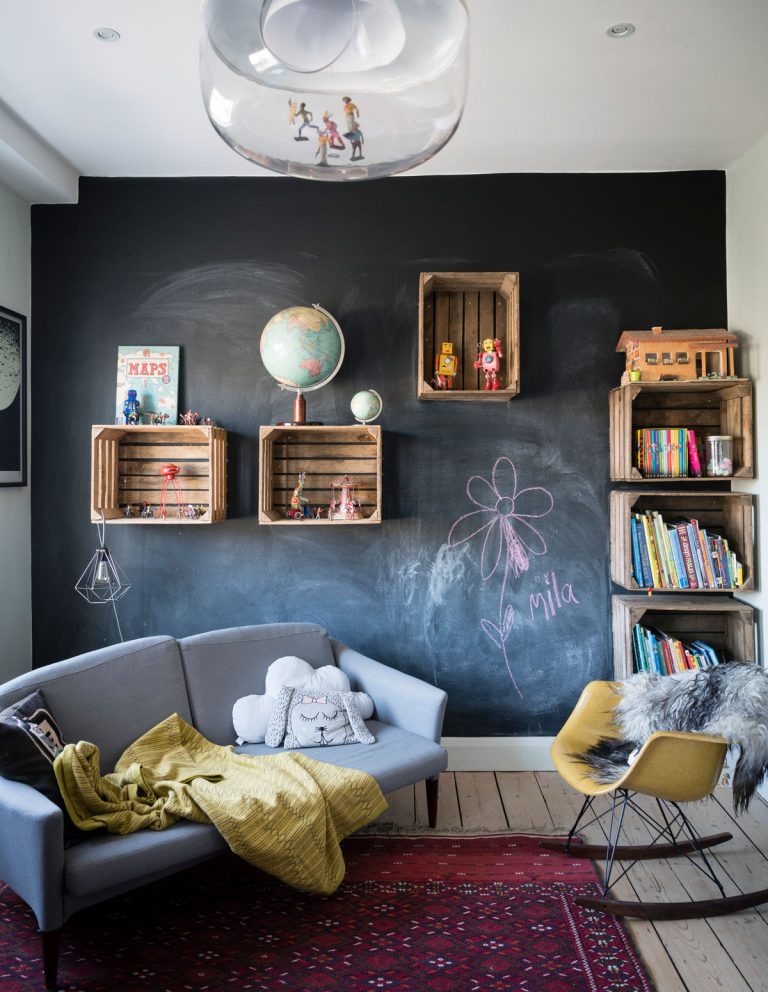
Want to add some extra toy storage? This is a fab DIY idea that's super handy and looks stylish – simply wall mount wooden crates to the wall and fill them with toys and books for a more creative way to keep everything accessible.
Lockers are a great kids' closet organizational tool. If you're a renter and can't hang things on walls, bring in a locker and place it against a wall. The brightly colored door fronts will add fun to the room. And, kids can be encouraged to put their projects and pieces inside these, and keep messes out of sight.
19. Use fireplace alcoves for playroom storage
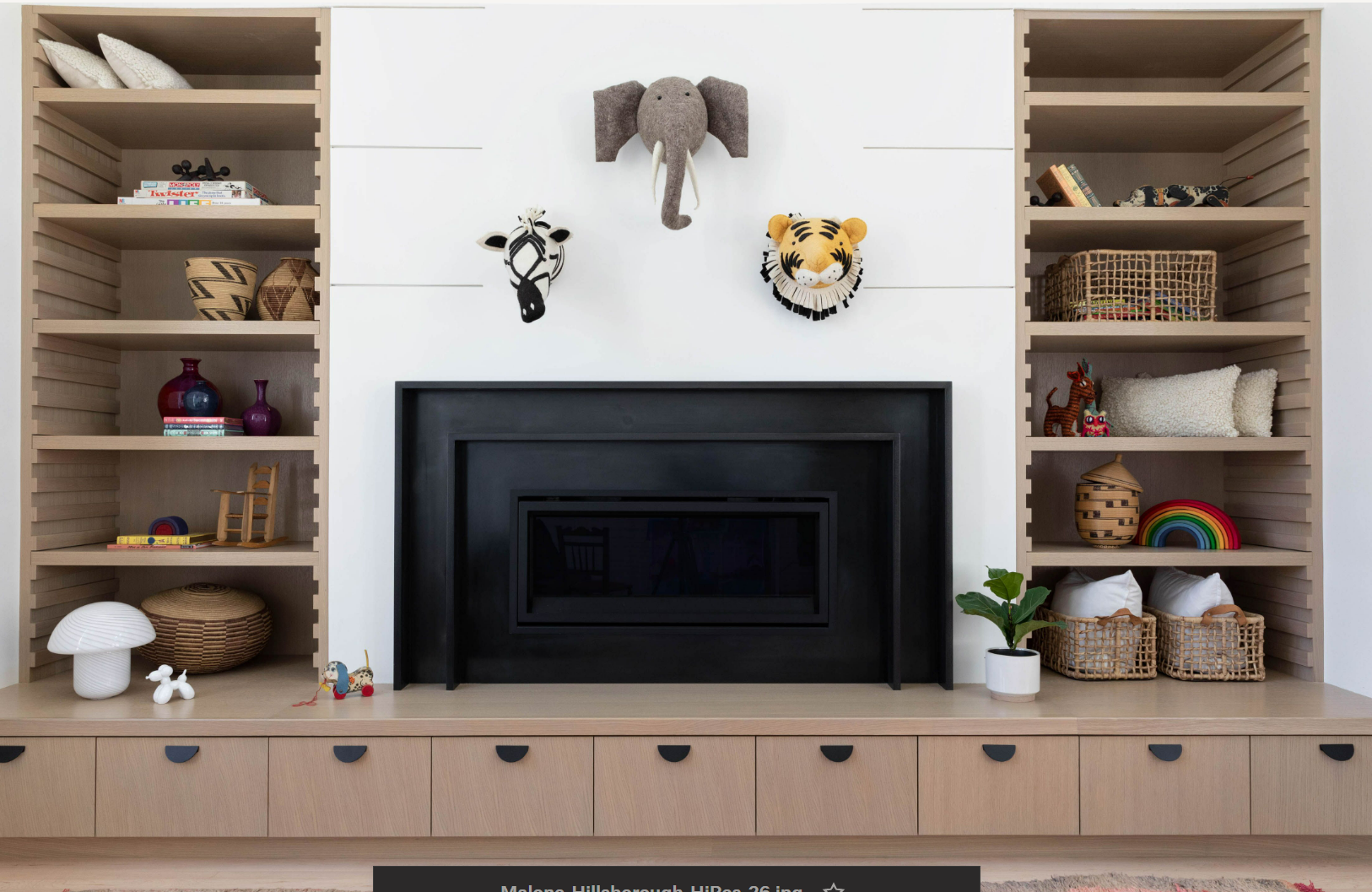
Running out of space in your small apartment? Double up the fireplace walls as a storage area for toys and other knick-knacks.
Use the space on either side and consider adding open storage there. Choose the prettiest toys, books, and artworks to display and make this almost like a curio cupboard. When friends and family visit, this storage space can become a conversation starter.
'The playroom in our Hillsborough residence was built with one thing in mind – kids,' says interior designer Malone Detro. 'Malleable, fun, and open, the room contains adjustable shelves and plenty of storage to act as a canvas for imagination and play.'
'The grooved rift oak shelving creates an opportunity for the kids to have a say in how their space gets organized, with the added benefit of wall to wall drawers for hiding costumes and playthings. The floorplan was left relatively open except for a Twilight sleeper sofa to encourage fun sleepovers by the fire,' says Malone.
20. Don't forget to add baskets for storage

The most useful storage solution is baskets because toys can be hard to manage, and the baskets allow users to simply dump everything in them.
'You are going to have toys, blocks, books, and more and you need a way to clean them up and stylishly store them,' say James Veal and Christine Stucker of design studio Stewart-Schafer.
'We love using woven baskets to store toys. Whether you have exposed shelves or bookcases, woven baskets offer a functional and chic solution to toy storage. We also like to use benches or poufs with additional storage. Incorporate furniture that doubles as additional storage solutions for a stylish and functional playroom,' say James and Christine.
21. Use the basement as a playroom
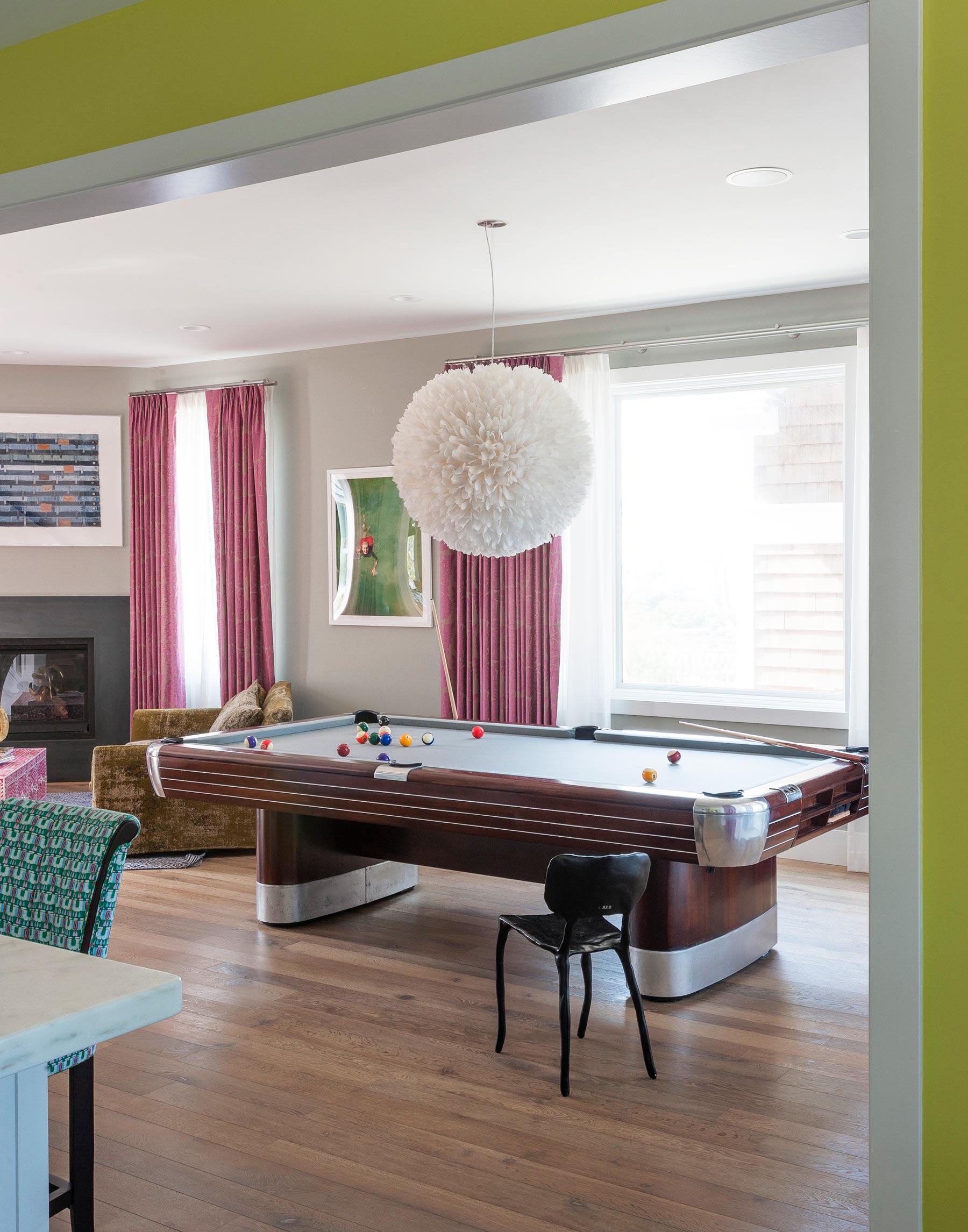
A basement is a fantastic place because it offers so many design opportunities. While many homeowners are intuitively lean towards basement bars, another great way to use this room is by converting it into a cool hang-out spot, complete with a pool table or table tennis or foosball.
Consider adding wall-to-wall carpeting here if you want to convert it into a complete playroom. Since kids end up on the floor often, it'll be a good idea to add softness underfoot.
Select furnishings that almost look like an extension of the adult area. Choose smart playroom furniture with kid-size craft tables and chairs that look coordinated with the space.
Bring in sliding doors, drapery panels, or even folding screens to section off the playroom from other areas in this space.
22. Start a movie night concept in the playroom
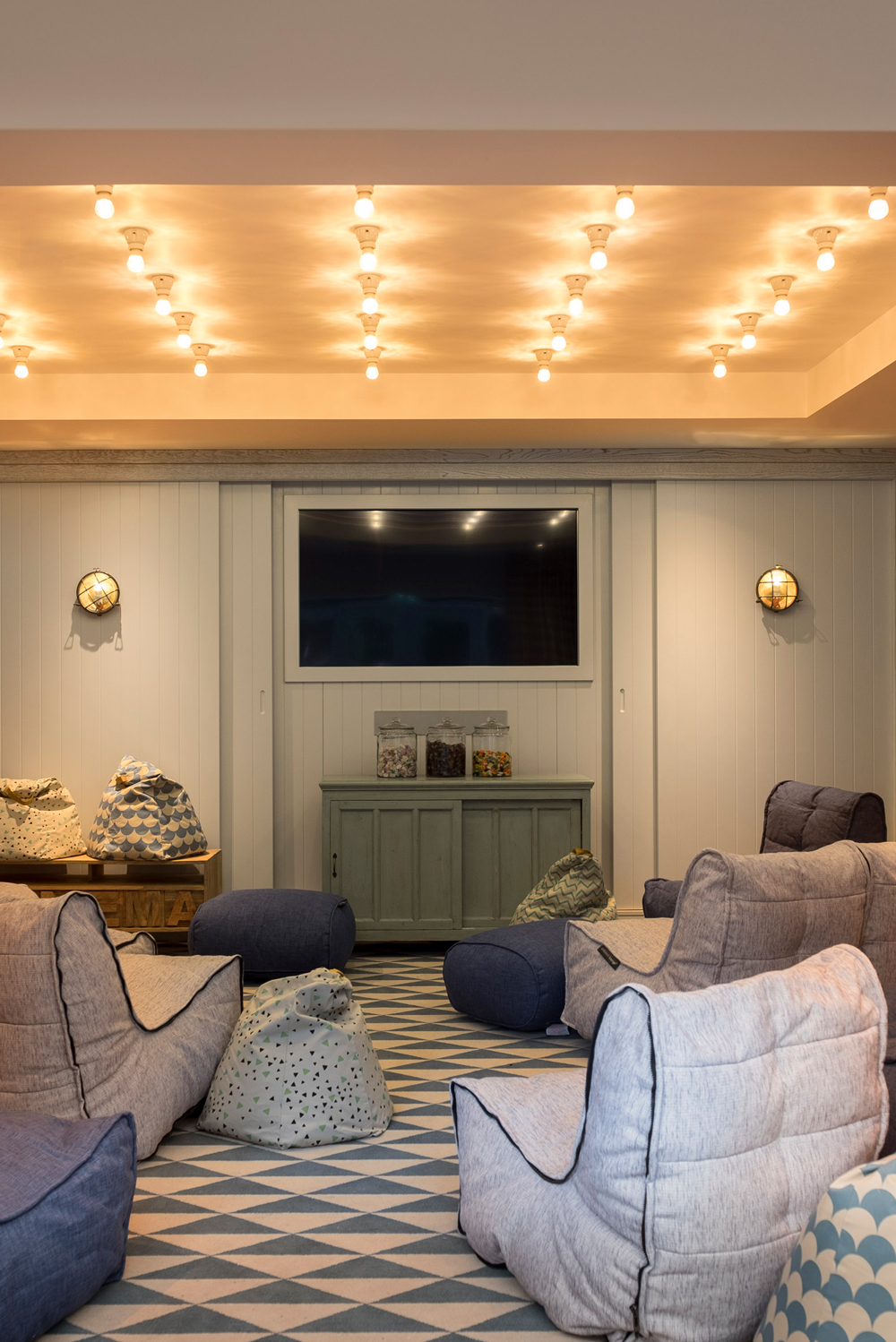
What could be better than a cinema for kids, complete with comfy bean bags? And even if you don't have a dedicated cinema room, it's a really easy look to recreate with a projector and a couple of comfy floor cushions in the small living room TV space.
Keep the weekends for movie nights – invite your kids' friends over. Add to this cinema room with board games so the children have something to do when the movie is over.
23. Create a rock star stage in a corner of the home

Set the stage, quite literally, in the house. Encourage the rockstars in them by creating a slightly raised stage for their music practice. This drum kit sits on its own raised plinth, made from the bandsawn oak floorboards.
Of course, having a music room in the middle of the house can become a little bit of discomfort. Consider using elements that keep the noise at bay. Area rugs with pads placed over tile or hardwood floors can help muffle sounds. Wool fibers have a higher rate of sound absorption than synthetic yarns. Other than that, honey-combed shades and insulated curtains can lower the sound reflecting off the glass.
24. Carve out a reading corner in your playroom
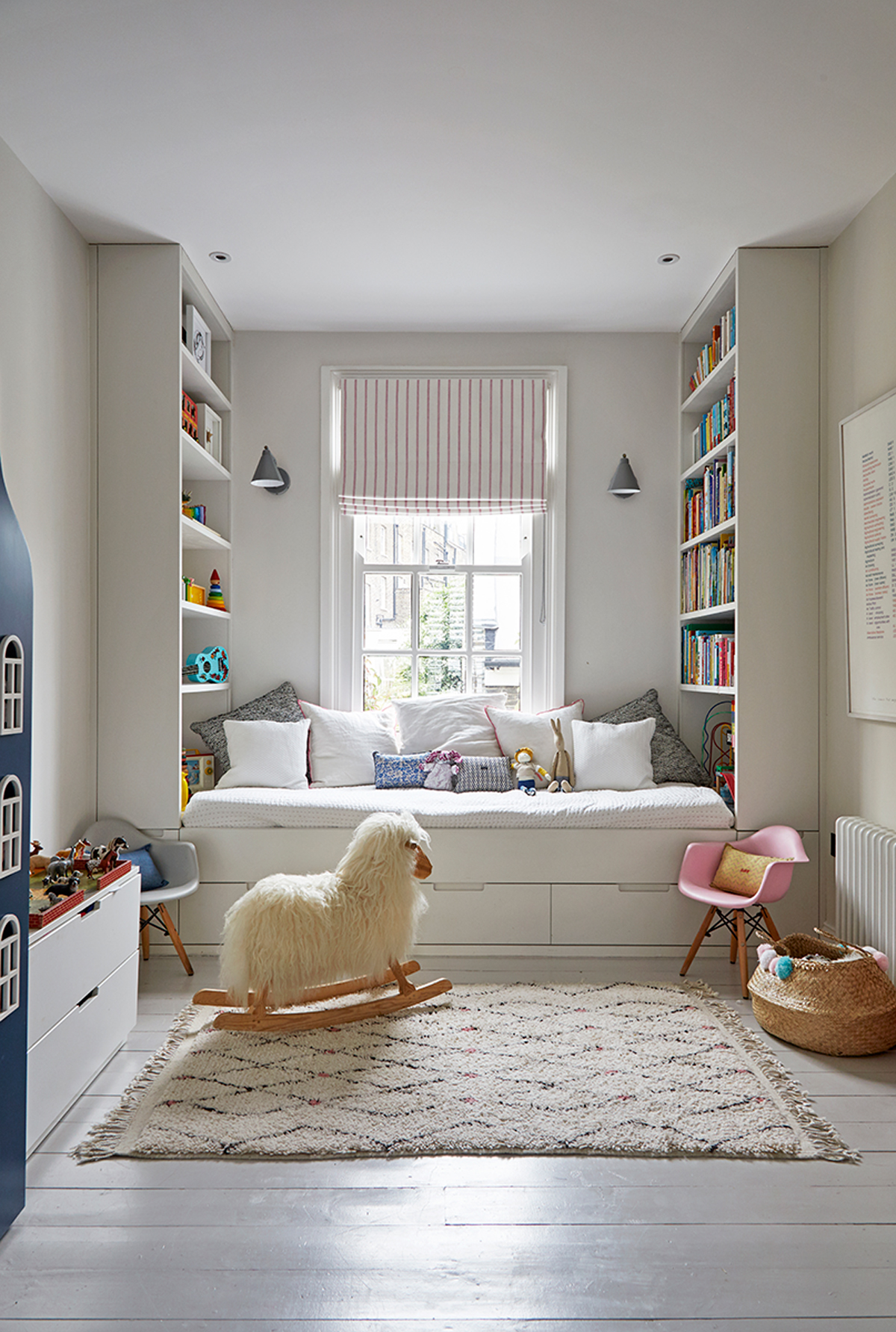
A reading corner is a perfect addition to a playroom, whether it's in the form of a window seat, cute accent chair, or a fabulous built-in as can be seen in this girl's bedroom.
If you have the space why not go with something that can double up as a guest bedroom, perfect for sleepovers.
25. Add ledges to increase playroom storage
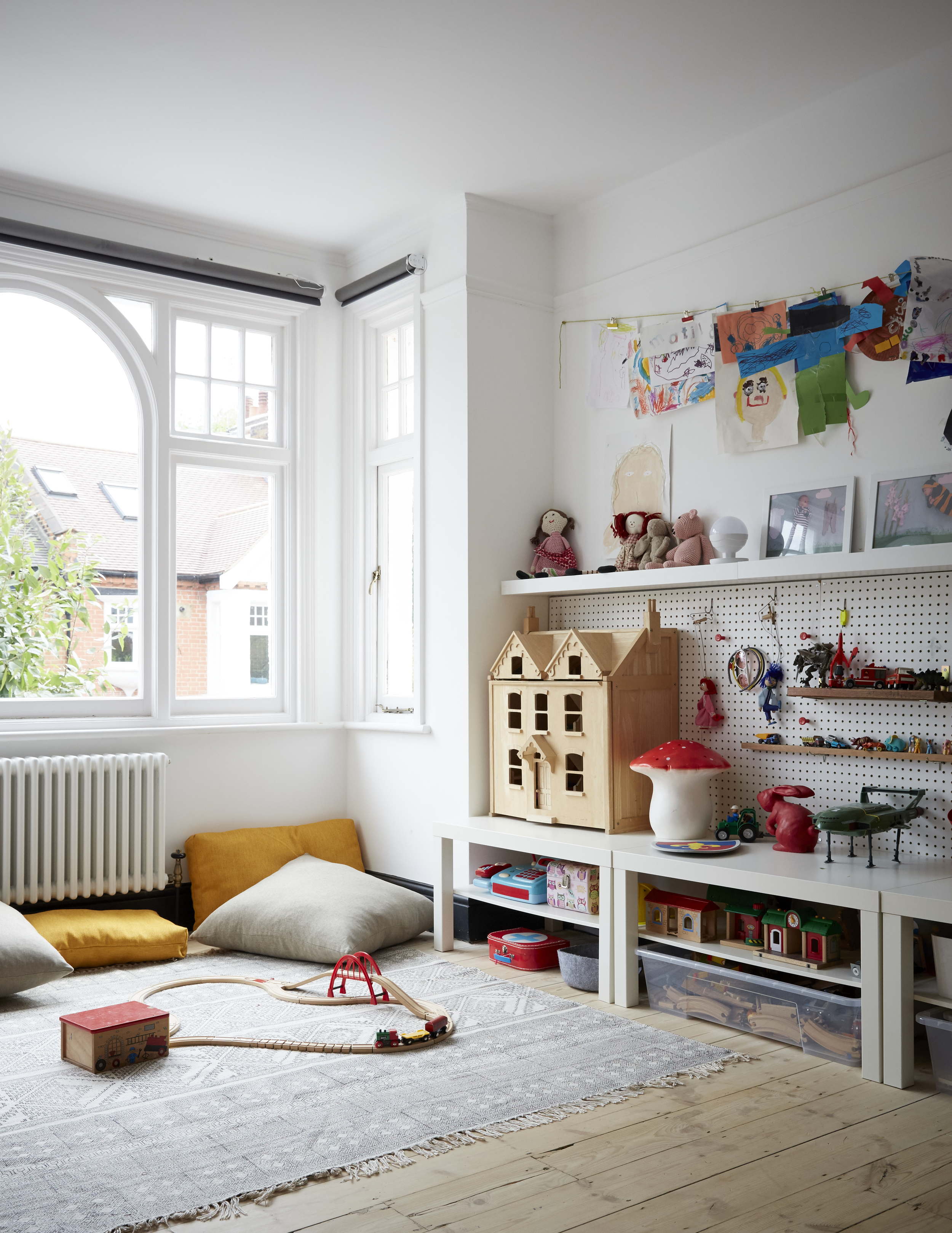
A pegboard wall provides a handy place to store outfits, and bags as well as doubles as a cool display space. In a playroom, this has many uses. From hanging outfits to other decoratives, it provides functionality and allows users to keep the precious floor space clutter-free.
A pegboard is super useful in a craft room as well, where the small tools and items can be kept within arm's reach. You can hang scissors, brushes, and crafting gadgets on it. In a bedroom for a teenager, where clothes, shoes, and bags multiply easily, having a pegboard installed inside the wardrobe helps keep things in order.
What is a playroom?
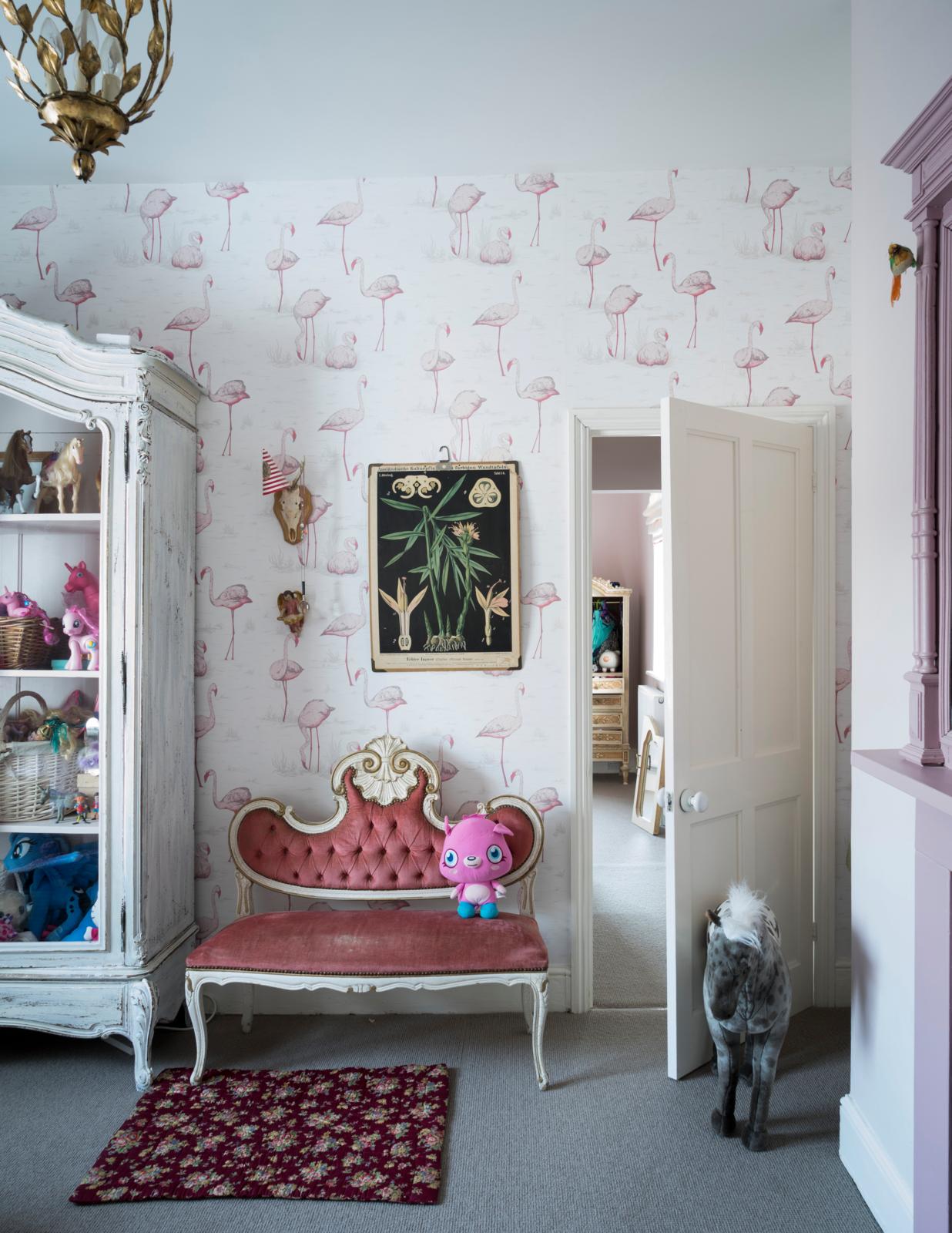
A playroom is a room that's entirely dedicated to children's toys and games. It usually incorporates storage to keep toys organized, and it could also feature arts and crafts supplies, crayons and paints, etc, as well as larger items like indoor play equipment including ride-on toys, rockers, or even a slide.
A good playroom is one that's designed to be interactive. With built-in dens and slides to mezzanine boat levels (like an indoor treehouse) and even wall pods that encourage climbing, the playroom is curated to keep a child happily entertained and occupied for hours.
What should be in a playroom?
A playroom should feature a carpet, soft rug, or play mat to make it more comfortable to play on hands and knees. It should also have smart toy storage that makes it easy to find toys and put them away again afterward.
Depending on the size of the playroom, you could even invest in a sofa and TV, an indoor treehouse, a slide or indoor climbing frame, or just a desk and arts & crafts area that's stocked with paints, pencils, crayons, papers, etc.
Be The First To Know
The Livingetc newsletters are your inside source for what’s shaping interiors now - and what’s next. Discover trend forecasts, smart style ideas, and curated shopping inspiration that brings design to life. Subscribe today and stay ahead of the curve.

Aditi Sharma Maheshwari started her career at The Address (The Times of India), a tabloid on interiors and art. She wrote profiles of Indian artists, designers, and architects, and covered inspiring houses and commercial properties. After four years, she moved to ELLE DECOR as a senior features writer, where she contributed to the magazine and website, and also worked alongside the events team on India Design ID — the brand’s 10-day, annual design show. She wrote across topics: from designer interviews, and house tours, to new product launches, shopping pages, and reviews. After three years, she was hired as the senior editor at Houzz. The website content focused on practical advice on decorating the home and making design feel more approachable. She created fresh series on budget buys, design hacks, and DIYs, all backed with expert advice. Equipped with sizable knowledge of the industry and with a good network, she moved to Architectural Digest (Conde Nast) as the digital editor. The publication's focus was on high-end design, and her content highlighted A-listers, starchitects, and high-concept products, all customized for an audience that loves and invests in luxury. After a two-year stint, she moved to the UK and was hired at Livingetc as a design editor. She now freelances for a variety of interiors publications.
- Lotte BrouwerFormer Digital Editor
-
 12 Essentials Every Cool, Collected Spring Host Needs — And You’ll Never Guess Where They’re From
12 Essentials Every Cool, Collected Spring Host Needs — And You’ll Never Guess Where They’re FromGuests will think you thought of everything, you just knew where to shop
By Julia Demer Published
-
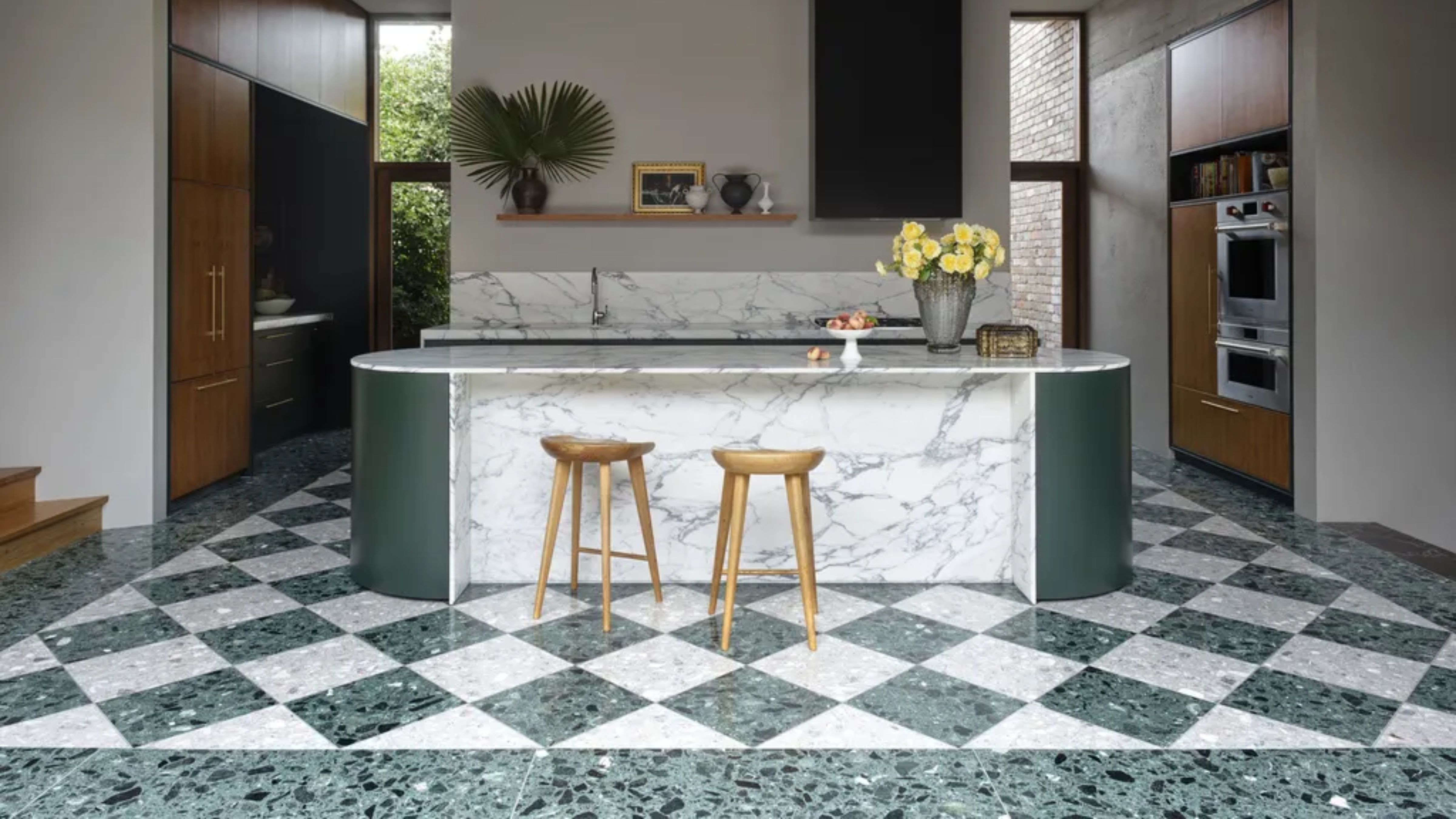 Smeg Says Teal, and We’re Listening — The Kitchen Shade of the Year Is Here
Smeg Says Teal, and We’re Listening — The Kitchen Shade of the Year Is HereDesigners are already using the soft, sea-glass green everywhere from cabinetry to countertops
By Julia Demer Published